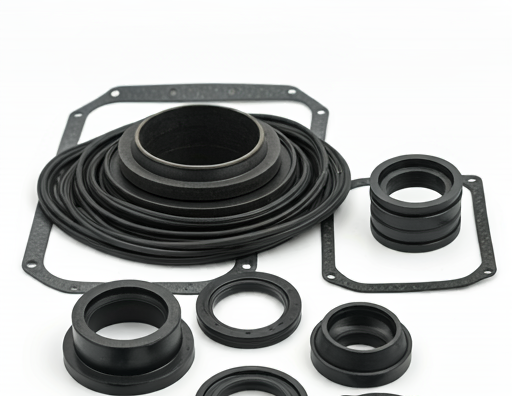Rubber gaskets are essential sealing components in industrial applications, playing a pivotal role in ensuring equipment performance and longevity. This article delves into the various types of rubber gasket materials, their properties, and how to select the most suitable material for specific applications.

Classification of Rubber Gasket Materials
Rubber gasket materials come in a wide variety, each with unique properties:
- Natural Rubber: Known for its elasticity, but with limited resistance to aging and oils. It is often used in applications with less stringent performance requirements.
- Synthetic Rubbers:
- Silicone Rubber: Offers excellent resistance to high and low temperatures, as well as chemicals. It is widely used in electronics and medical applications.
- Fluorocarbon Rubber: Exhibits superior resistance to high temperatures, oils, and chemicals, making it suitable for harsh environments.
- Nitrile Rubber: Known for its oil resistance, wear resistance, and tear strength. It is commonly used in automotive and mechanical applications.
- Ethylene Propylene Diene Monomer (EPDM) Rubber: Offers excellent resistance to ozone and weathering, making it ideal for outdoor applications.
- Other Specialty Rubbers: Such as chloroprene rubber and ethylene propylene diene monomer rubber, which possess unique properties.
Industry Applications
Rubber gaskets are integral components in numerous industries:
- Automotive Industry: Gaskets ensure proper sealing in engines and fuel systems, preventing leaks that could lead to performance issues or safety hazards.
- Chemical Processing: Gaskets made from materials like Viton provide essential sealing solutions in environments with aggressive chemicals.
- HVAC Systems: Neoprene gaskets are commonly used in heating and cooling systems to maintain efficiency by preventing air leaks.
Selection of Rubber Gasket Materials
Choosing the right rubber gasket material is critical for ensuring effective sealing in various industrial applications. With numerous options available, understanding the characteristics, advantages, and specific applications of each material can significantly impact performance and longevity. This guide aims to provide an in-depth exploration of rubber gasket materials, helping professionals make informed decisions.
Key Factors in Material Selection
When selecting a rubber gasket material, several key factors should be considered:
- Operating Conditions:
- Temperature Range: Identify the minimum and maximum temperatures the gasket will encounter.
- Pressure Range: Determine the pressure levels the gasket needs to withstand.
- Chemical Compatibility: Assess the chemicals or fluids the gasket will contact to ensure material resistance.
- Environmental Factors: Consider exposure to UV radiation, ozone, and other environmental conditions.
- Material Types and Properties:
Understanding the various types of rubber materials is essential for making the right choice. Below are some common rubber gasket materials along with their properties and applications:
| Material | Temperature Range | Chemical Resistance | Applications | Advantages |
|---|---|---|---|---|
| Nitrile | -20°F to +250°F | Excellent | Oil seals, fuel gaskets | Good abrasion resistance |
| Neoprene | -65°F to +250°F | Moderate | Outdoor applications | Weather-resistant |
| EPDM | -50°F to +300°F | Good | Automotive, food processing | Excellent weather resistance |
| Silicone | -80°F to +550°F | Excellent | Food-grade, high-temperature | High flexibility |
| Viton | -20°F to +400°F | Superior | Chemical processing | Long-lasting performance |
Specific Application Considerations
- Food and Beverage Industry: For gaskets in food processing, materials like EPDM or silicone that comply with FDA regulations are recommended.
- High-Temperature Applications: Silicone or Viton materials are preferred for their ability to withstand elevated temperatures.
- Chemical Resistance: Selecting materials that resist specific chemicals encountered in your application is crucial for maintaining integrity over time.
Future Development of Rubber Gasket Materials
With advancements in technology, rubber materials are continuously evolving. The emergence of new materials such as liquid silicone rubber and fluorosilicone rubber offers broader applications for rubber gaskets. Additionally, the application of composite materials and intelligent materials will further enhance the performance of rubber gaskets.
Conclusion
Understanding the various types of rubber gasket materials is crucial for selecting the right gasket for your application. Each material offers distinct advantages that cater to specific industrial needs. Selecting the appropriate rubber gasket material is vital for ensuring optimal performance in sealing applications across various industries. By considering factors such as operating conditions, material properties, and specific application requirements, professionals can make informed decisions that enhance efficiency and reduce maintenance costs.For tailored advice on selecting the right rubber gasket material for your specific needs or to explore custom solutions, we invite you to contact our technical team today. Let us help you find the perfect sealing solution that meets your operational demands!







